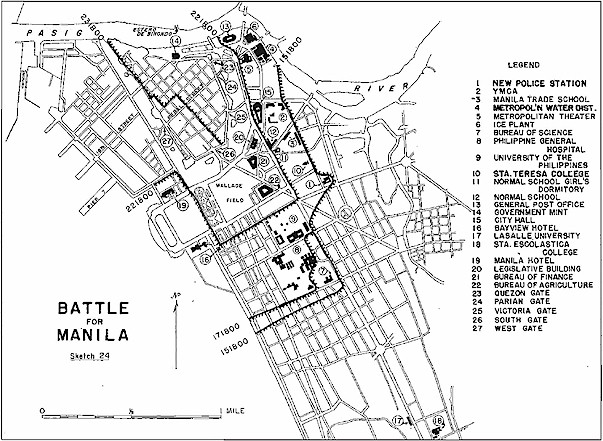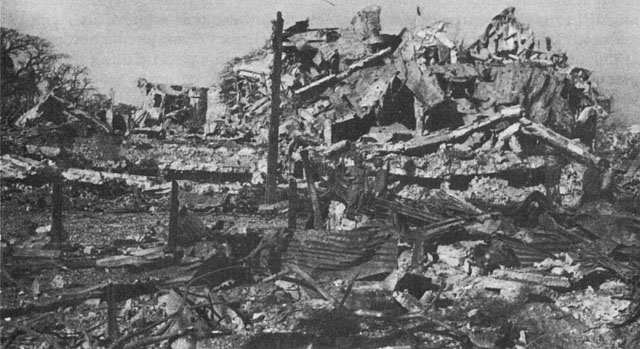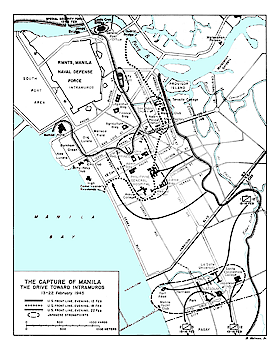|
Elements of the 37th Division continued to push to the West, but the
progress was slow. The 3d Battalion 129th Infantry, moving along the South
banks of the PASIG, gained only 400 yards on the 15th of February against
sharp enemy resistance from machine-gun and 20-mm guns in well concealed
pillboxes. At the close of day on the 15th, the 3d Battalion had
straightened its line to run South from the PASIG RIVER along the East
edge of the Military Hospital to San Marcelino, thence South on San
Marcelino to join with the 1st Battalion. (See
Sketch No. 24).

Sketch
No. 24
The 1st Battalion of the 129th Infantry had succeeded in getting into a
building at the intersection of Isaac Peral and San Marcelino Streets on the
15th, but withdrew under the cover of darkness. This building was later
identified as the New Police Station and, similar to all new buildings in
MANILA, was of earthquake-proof construction. On the morning of the 15th,
the attack against the building was launched again, supported by heavy
mortar concentrations, direct fire from 105-mm self-propelled guns, and
medium tanks. Troops penetrated the building through heavy machine-gun fire
and secured the ground floor capturing 5 machine guns and repulsing a
counterattack. By 1800 on the 15th, the enemy had been cleared from all the
building except the basement. On the 16th, the entire building was secured.
The following photograph shows the nature of the
defense of the building.

While elements of the 1st Battalion were
reducing the New Police Station on 15-16 February, a similar fight was in
progress in the Santa Teresa College area East of San Marcelino. Supported
by artillery, 81-mm. and 4.2 mortars, self-propelled 105-mm, and medium
tanks, on the 17th of February Company B, 129th Infantry, employing close-in
infantry assault tactics, succeeded in neutralizing the enemy in one of the
buildings near the college. On the 18th of February, the 129th Infantry
(less 2d Battalion) was relieved in place by the 145th Infantry (less 2d
Battalion). Thus, on the latter date, the 3d Battalion 129th Infantry was on
the right of the line with the 1st Battalion 145th Infantry on the left.
This latter unit immediately launched an attack against the Santa Teresa
College and secured the building on the same day.
The 148th Infantry, between the 129th Infantry on the North and the
Cavalry on the South, found that it could move with its left much more
rapidly than with its right. On the 15th of February the 3d Battalion, on
the South, had pushed to the line Mabini - Carolina streets, two blocks
East of MANILA BAY. On 17 February the 1st Battalion, which had relieved
the 3d Battalion on the 16th, attacked North and seized positions along
Herran Street from MANILA BAY to Wright street, where contact was made
with the 2d Battalion. The 2d Battalion, in the North of the regimental
zone, continued slow but relentless destruction of enemy positions at the
Philippine General Hospital and the University of the Philippines. In
these latter positions, the enemy defended by employing 40-mm, 20-mm,
dualpurpose.guns and grazing fire from machine guns.
In Manila the Philippine General Hospital occupies a large city block
between Taft Avenue on the East, Dakota Avenue on the west; Herran Street
on the South, and Faura street on the North. There are several buildings
on the site, of which the Science Building and the Medical School are on
the South, the Hospital proper in the center, and the nurse's quarters on
the North. Across Faura Street to the North and abutting on Taft Avenue is
the campus of the University of the Philippines. It was around these
humanitarian and cultural centers that one of the hardest fought battles
of MANILA took place (See
Sketch No.
25).
At 0830 on February 17th, the 148th Infantry launched a determined attack
to secure the Hospital and the University. The 1st Battalion drove North
and seized the buildings along Herran Avenue, while the 2d Battalion in
fierce hand to hand fighting secured the Science Building at 1150, the
Nurses Home at 1730, and the two Eastern wings of the hospital at 1330. In
the hospital proper, the 2d Battalion found several thousand interned
eivilians, 2000 of whom were liberated in the afternoon, and an estimated
5000 throughout the night. In face of point blank machine-gun and rifle
fire the Battalion drove to positions from which it could neutralize enemy
guns in the University of the Philippines. On the night of the 17th - 18th
the enemy was driven from the west wing of the Hospital, but occupation of
the wing was denied the American forces by enemy fire from the Medical
pahool and the Observatory. At 0900, 18 February, the 1st Battalion,
supported by tanks and tank destroyers, secured the Medical School and
permitted Company E to occupy the West wing of the hospital. Company C on
the extreme left of the 1st Battalion pushed North along MANILA BAY and
secured a line along Faura Avenue from the Bay to Dakota Avenue. This
company received rocket fire from the High Commissioner's House at 1455.
The situation at sunset on the 18th showed a line running along Faura
Avenue from MANILA BAY to Dakota, while in the Hospital grounds the enemy
stubbornly refused access to the Convent (Southwest grounds). It was along
this line that the 1st Cavalry Brigade (less 1 Squadron) took the left and
the 5th Cavalry the right. The 5th Cavalry continued the reduction of the
Medical Building, which was finally secured on 20 February after vigorous
close-in assault action in which flame throwers were employed. After the
reduction of the Medical Building the 2d Squadron ot the 5th Cavalry,
which was on the lett ot the regimenta1 front, pushed on to Faura Street
where it came under enemy fire from the grounds of the University of the
Philippines. The Squadron succeeded in occupying the East building (Marked
A, on Sketch No. 25). The 1st Squadron 5th Cavalry moved East along Isaac
Peral from Taft to Camillas Streets, making contact with elements of the
145th Infantry. At 0830 on the 20th the 1st Squadron launched an attack on
the University Building, by 1130 had secured the 1st floor of the
building, and by 1630 occupied one-half of the 2d floor. At 1630 the
building exploded, evidently trom mines emplaced by the enemy. The
Japanese resisted stubbornly in all buildings of the University until 1645
22 February when all resistance was eliminated.
While the 5th Cavalry was reducing the University of the Philippines, the
1st Squadron of the 12th Cavalry attacked the High Commissioner's Home at
0730 20 February, and by 1000 had cleared the house and reached Isaac
Peral Street. At 1100, the Army and Navy Club and the Elks Ciub were
secured, and patrols were sent through the Burnham Green area to the
vicinity of the Manila Hotel. They found the area heavily mined and
fortified, but positions unoccupied. Outposts in the Burnham Green area
received heavy machinegun and rifle fire from the INTRAMUROS on the night
of 20-21 February. On the 21st the 12th Cavalry penetrated the Manila
Hotel, where intense hand to hand fighting took place. At 1800 the enemy
was holding the mezzanine floor while American forces held the lobby. It
was not until 1645, 22 February that the Manila Hotel was completely
cleared. (See
Sketch No. 19).
While the 148th Infantry and the Cavalry were fighting in the Hospital and
University area, the 129th Infantry (less 2 battalions) continued to meet
opposition from fortified buildings West of San Marcelino Street, until
relieved by the 3d Battalion 145th Infantry on 18 February. The 129th
Infantry was then assembled at Caloocan on the North side of the PASIG,
while the 145th (less 2d Battalion) was in position South of the PASIG
with the 3d Battalion on the North and the 1st on the South. While
attacking the New Police Station at 1600 February 18th, the 1st Battalion
met flanking fire of 40ˇmm and 20-mm caliber from the San Pablo Church,
which positions were assaulted but had to be abandoned during the night of
18 - 19 February. On the 19th another attack was launched against the San
Pablo Church area, and by nightfall one-half of the Convent Building had
been secured. By 1800 on the 20th, both the Church and the Convent were
reduced. The 3d Battalion 145th Infantry attacked North and West from a
line of departure on San Marcelino Street at 1230 19 February, and after
fierce hand to hand fighting against strongly emplaced enemy, by 1435 had
seized the Y.M.C.A. and Manila Trade School, and was on the Eastern side
of the Metropolitan Water District Building. Patrols moving along the
South bank of the PASIG reached a point 200 yards Southeast of Quezon
Bridge when they drew enemy fire from the Post Office (GPO) and the Ice
House. Continuing the attack on the 20th, the 3d Battalion met resistance
from the Girl's Dormitory (Southeast corner of Taft and Ayala) and the
Normal School diagonally across the street. These buildings were brought
under fire by tanks, mortars, and 76-mm guns of tank destroyers, and the
Girl's Dormitory was secured. The Normal School could not be entered until
1300, 21 February, but after one and oneˇhalf hours of intense hand to
band fighting this last building was cleared.
The City Hall was another building difficult to reduce. Company K 145th
Infantry penetrated the City Hall 20 February, entering through a breach
made in the East Wall by point blank fire from M-7's (105-mm howitzer).
The company found the building heavily fortified and withdrew to allow a
heavy concentration of white phosphorous shell to be brought down upon it.
On February 21st, Company I entered the City Hall only to find that
further penetration was denied by numerous heavy concrete walls and
sand-bagged, barricaded doors. At 1800 on the 21st of February the troops
again withdrew to permit direct fire from l55-mm howitzers, 76-mm and
75-mm guns. On the 22d, another point blank artillery preparation was
fired, after which the 3d Battalion again forced entrance into the HaIl.
After fierce hand to hand fighting from room to room, complete command of
the roof was secured at 1145, and at 1450 the building was in our hands
with a total of 206 counted enemy dead. The Metropolitan Water District
Building was secured by the 3d Battalion at 0920, 21 February, (by Company
I while Company L reduced enemy rifle fire from the Botanical Gardens and
entered the Metropolitan Theater at 1405 the same day. Company B 145th
Infantry entered the Ice House at 1630 and after using intense point blank
fire from 76-mm guns and tanks, destroyed remaining pockets of enemy
within the burning building. Another direct fire preparation was laid on
the General Post Office, after which Company B entered the building.
Fierce close-in fighting from room to room during the night secured the
first two floors by 1145 22 February, and the top five floors by
1220 that day. On the 2d fioor our troops destroyed a 75-mm gun. At 1800
on the 22d the enemy still held a small area in the West half of the
basement which was soon cleared by flame throwers and pole charges.The
American flag was then raised over the building. At sunset on the 22d, the
line ran from the PASIG along the West side of the GPO South along Taft
Avenue to Isaac Pera1 Street, thence West along Isaac Pera1 to Dewey
Boulevard, thence North along Dewey Boulevard to the Northeast corner of
Manila Hotel, thence West to the Bay. (See
Sketch
No. 24).
Further tightening of the ring about the INTRAMUROS necessitated a
decision as to how the Walled City would be invested. Wallace Field, and
government buildings in the triangle enclosed by Taft Avenue, Gral Luna,
and Burgos streets conclusively proved that penetration of the walls
from the South and East would be more expensive in American lives than an
amphibious attack across the PASIG RIVER. Information obtained from
escapees from the INTRAMUROS also disclosed that the major defenses within
the wall itself were directed toward the South and East. These defenses
consisted of mined areas, barbed-wire obstrutions, and tank traps, all of
which were covered thoroughly by machine guns and mortars. Along the
PASIG, however, information disclosed that the strongest enemy defenses
were between the Mint and the Jones Bridge, and that West of the Mint the
wall was lightly defended. (See
Sketch No. 26).
Escapees from the
Walled City had also told of an elaborate tunnel system by which troops
could move from one part of the city to another and also within the wall
itself, hence it was appreciated that, regardless of the direction of the
attack upon the City, the enemy could move reinforcements quickly from
one locality to another without them being subjected to harassing
artillery fire.
It was well known that corralled within the Walled
City were many non-belligerents, the majority of whom were women and
children. Foreseeing that the occupation of the INTRAMUROS was necessary
for the complete reduction of MANILA, the Corps Commander, on the 16th of
February, requested the Commanding Officer of the Japanese forces to allow
the internees to leave the City. This message, reproduced below, was
broadcast in Japanese from the North side of the PASIG at 1330 16
February, and followed by radio on frequencies which the enemy could
receive.
"Your situation is hopeless -your defeat inevitable. I
offer you an honorable surrender. If you decide to accept, raise a
large Filipino Flag over the Red Cross Flag now flying and send an
unarmed emissary with a white flag to our lines. This must be done within four hours or I am coming in. In event you do not accept my offer,
I exhort you that, true to the spirit of the BUSHIDO and the code of
the SAMURAI, you permit all civilians to evacuate the INTRAMUROS by the
Victoria gate without delay, in order that no innocent blood be shed."
This message went unheeded by the Japanese commander. However, prisoners
of war subsequently captured stated that many of the Japanese soldiers
desired to give themselves up after hearing the broadcast, but were
forbidden to do so by their officers.
Receiving no response from the plea to evacuate the civilians, plans were
immediately formulated for the invasion of the Walled City. The
possibility of aerial bombardment of the area was considered, but was
rejected as inadvisable because of the civilians interned therein;
therefore, the reduction would have to be done by artillery and smallarms
fire, and assault by rifle troops. Two days after the broadcast of the
Corps Commander, artillery was brought to bear upon targets within the
INTRAMUROS. Besides targets which were definitely known to be enemy
observation posts, mortar and artillery emplacements, there was the
ponderous task of breaching the wall. The ramparts surrounding the old
city were of stone blocks laid in a mortar of 16th century vintage, which
had become more formidable with age. The wall was 40 feet thick at the
base, and tapered through 16 feet of height to a width of 20 feet at the
top. Certain information had indicated that the masonry had been tunnelled
by the Japanese to permit shifting of machine guns among the
emplacements.. However, it was not believed that throughout the entire
length of the wall this had been done. It being impossible to tell which
part of the rampart was hollow and which was not, tactical consideration
alone was the basis for choosing the place for making the breach through
which advancing infantry could penetrate the city.
For the breaching, two points were chosen on the East wall of the City.
One was North of Parian Gate, and the other between Parian Gate and
Victoria Gate. One breach was made by 8-inch howitzers using indirect
fire, and the extreme accuracy of this weapon is attested by the
relatively clean cut made in the masonry as shown in accompanying
photograph. 150 rounds of 8-inch howitzer shell were used in blasting this
gap. The other breach was made by direct fire from 155-mm howitzers using
150 rounds, followed by 8-inch howitzers firing 29 rounds to clear the
debris. The breach made in the wall by the fire of 155-mm howitzers of the
756th Field Artillery Battalion is shown in the following photograph.
On the 19th of February, the walls had been successfully breached, and the
129th Infantry was assembled at CALOOCAN. It was definitely decided that
the assault upon the INTRAMUROS would initiate with an amphibious crossing
of the PASIG RIVER by the 129th Infantry, while the 245th Infantry moved
overland West and through the breaches made by the artillery. The 129th
Infantry was to enter the INTRAMUROS through the openings in the wall in
the vicinity of the Mint. The tide in the river, which reached the high
point in early afternoon, was a factor which could not be overlooked. Both
banks of the PASIG RIVER had been walled with rubble, and at low tide it
would be quite difficult for troops to scale the river banks. The tide
could not be the controlling factor.
|


